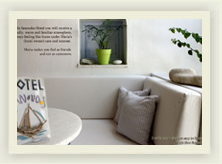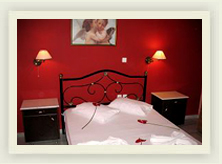The Archaeological Museum of Naxos is housed in a historic five-storey building, constructed in the 17th century to house the School of the Jesuits of the island. The building developed along the Frankish castle, incorporating two of the towers of the castle. In late 19th century the building was the seat of the well known Commercial School of Naxos, among the students of which was the famous Greek author Nicos Kazantzakis. Later on, the building was allotted to the Archaeological Service of Greece and since 1973 it houses the Archaeological Museum of the island.
Numerous exhibits are very important and come from the excavations carried out on the island the last 60 years. The finds displayed cover a period of more than 6000 years, from the Neolithic Period up to the Early Christian era. Of course, the most outstanding among them is the collection of Cycladic statuettes of marble, dated in the Early Cycladic period (3200 -2300 b.C.). The collection of the Museum for this period of history is considered by specialists of equal importance and archaeological and artistic value with those housed in Athens, in the National Archaeological Museum and in the Museum of Cycladic Art. Apart from the Early Cycladic collection, the Museum has also rich collections of typical vessels of the Mycenaean period and of Geometric times (9th and 8th century b.C).
The more recent periods are represented by nice ceramic vessels and clay statuettes, along with a few sculptures from the Archaic Period. An important collection of glass vessels come from the Roman period of the island.Exhibits from almost all the archaeological sites of the island are displayed in the Museum: finds from Grotta and other sites in the town of Naxos, from Melanes, Sangri, Yria, Tsikalario, Panormos and others.

The following museums operate in Chora;
Naxos Archaeological Museum
The Naxos Archaeological Museum is housed in a building which constitutes a representative sample of the island’s architectural style during the Latin rule and it is located in one of the narrow ascending alleys which lead to the castle.
The building was housing once the Jesuits’ Academy; in the late 19th century-early 20th century, the building housed the known “Emporiki Scholi” (Schoul of Comerce) which was visited by Nikos Kazantzakis, while in 1973, the building was given to the Ministry of Culture.
The archaeological collections of the museum include important finds from excavations made in Naxos and in the neighbour islands and are dated from the early Neolithic Age until the late Roman Period.
The Naxos Archaeological Museum is famous for its two very important collections, the Cycladic and the Mycenaean.
The first collection includes finds from the First Cycladic Period which extends from the late 4th century B.C. to the late 3rd century B.C. a period during which, the Cyclades were an important centre of cultural development. In addition, in the museum are exhibited finds dated to the geometric
period (amphora and pots with abundant decoration) and a lot of samples of the geometric architecture which were found on the island’s tombs, i.e. golden and objects made of clay. Finally, go up to the museum’s terraceto admire the unique mosaic flooring that was found in aresidence of the 3rd century B.C. and depicts a semi-nude figure of a woman which is riding a sea monster.
Working hours; Daily, except for Monday; 08:30 – 15:00.
Entrance fee; 3 euro
(reduced fee for students and people over 65 years old ;
2 euro). Tel; 2285022725
Metropolis Site Museum
It is an unusual museum, designed by Agni Kouvela. It is located in the square of the Orthodox Metropolitan Cathedral and displays an important collection of finds from the ancient town of Naxos. The collection includes significant finds and indoor images with a gradual chronological transition from the Mycenaean period (1300 – 1100 B.C.) to the Geometric period (900 – 700 B.C.). From the Mycenaean period, a big part of the town’s walls is preserved in good condition. On the foot of the walls, one can discern small vessel workshops which give unique information about the manufacture of that age. From the Geometric period, it was found an altar, which is surrounded by broken pots. This was part of an earthen tomb which was constructed to cover the graves of prominent Naxians. The enlightening designs, the ground plans and the representations of the ancient town will help you understand better the space, the finds and the historic transition from one collection to another. Working hours; Tuesday – Sunday, 08:30 – 15:00. Free entrance. Tel: 2285024151.
Venetian Museum (Domus Della Rocca Barozzi)
The well preserved tower owned by Nikos Karavias, which is situated in the castle of Chora, has been converted into a unique folklore museum which houses furniture and objects dated to the 17th-19th century, all belonging to a common household of that age. The Venetian Museum is a representative sample of the Naxian mansion house with influences from the West. The owner of the tower will guide you in themuseum and will take you to another age in a very special way! Working hours; Daily (April - end of October) 10:00 – 15:00 and 19:00 – 22:30.
Entrance fee 6 euro (including guidance in Greek, English, French, Italian and German). Reduced fee for students; 4 euro . Tel; 2285022387.
In Apeiranthos, you will find the following museums;
The museums houses finds of the prehistoric ages (pottery, Cycladic idols, earthen pots, e.t.c.), which were brought to light by excavations made in different locations on the island. The most important finds – due to their rareness – are the dark coloured plaques with striking decorations from the Korphi t’Aroniou, a small altar on the southeast shore of the island. The museum operates daily except for Monday, from 08:30 to 15:00. Free entrance. Tel; 2285061725.
Geological Museum
The Geological Museum with a collection of more than 2,000 rare exhibits (samples of minerals, rocks, metals and relics), is situated in the main road of the village. The emery has a prominent position in the museum, while there are displayed metals from other Cycladic islands as well as from other regions of the planet as, like rocks from Mt. Etna and Mt. Vezouvios.
The museum operates daily from 10:30 until 14:00 and the entrance fee costs 1,5 euro, including visit to the folklore museum. Tel: 2285061724.
The folk Art Museum
It is about a typical reconstitution of the interior of a common house in Apeiranthos, located in the central square of the village. The museum houses traditional weavings, tools, cooking utensils and bedroom furniture.
The museum opens its doors to the public daily from 10:30 – 14:00, while in July and August, it will remain apen until 17:00. Entrance fee: 1,5 euro (including visit to the Geological Museum). Tel: 2285061629, 2285061158.
Natural History Museum
The museum was inaugurated in 1996 and has two different halls, one devoted to the sea and one to the land. The first one includes among other things a large natural aquarium as well as superb collection of clams which were found on the island. In the first hall, the most important exhibit the flora that was found in the hydrological basin of the Perachoritis torrent, while there are also displayed samples of Naxos’ fauna, mainly bones of various mammals. The museum is open on a daily basis from 10:30 – 14:30, while during high season (July-August) it remains open from 10:30 to 17:00. Entrance fee: 1 euro. Tel: 2285061622,42072
Following museum is worth visiting in Sangri…
Gyroulas Archaeological Museum
In the archaeological site of the ancient temple of goddess Dimitra in Sagri, you will see a very important museum which houses finds that give evidence to the holiness of the place as well as the architectural parts of the monuments which were not included in the reconstruction of the temple.
The museum is divided into two halls. The first hall is devoted to the usage of the sanctuary from the 8th to the 3rd century B.C. Among other exhibits, the most important are: The restored pediment and part of the inner colonnade as well as the roof of the antique temple. The kouros (meaning “handsome man”) sculptures and the votives with inscriptions which were offered to the gods are of the same importance.
The second hall is devoted to the old Christian Basilica, the temple that was built at the same place in the 6th century B.C. and was surrounded by a monastery. The museum displays the inner parts of the temple, pieces from the pulpit as well as a marble window. In addition, among the exhibits you will see remnants of the pottery workshop i.e. patterns and oil lamps.
During the “Christian centuries” (6th-16th centuries) Naxos was lucky to have a set of monuments – churches, which were recognized from the begging of the 1930s (Prof. Kalogeropoulos). From a first evaluation and taking under consideration the number of monuments in the island ( as far as architecture and visual arts is concerned ), more than in any other island of the south Aegean, except Crete.














